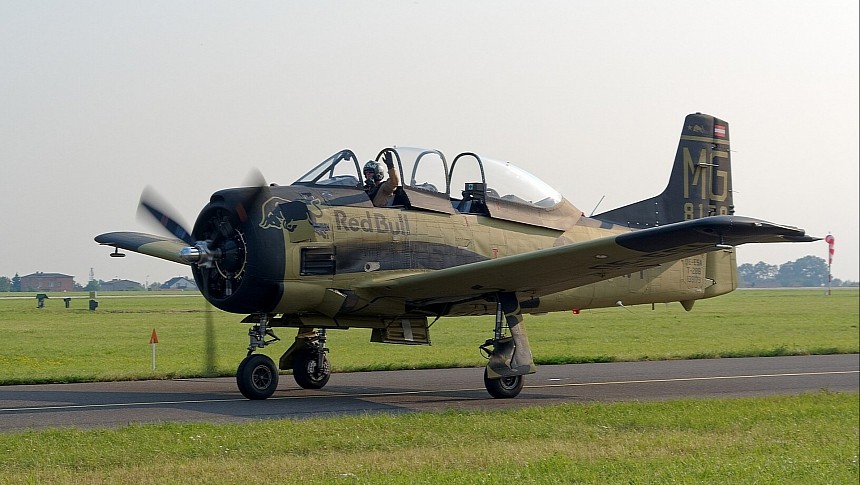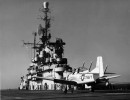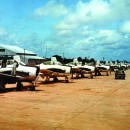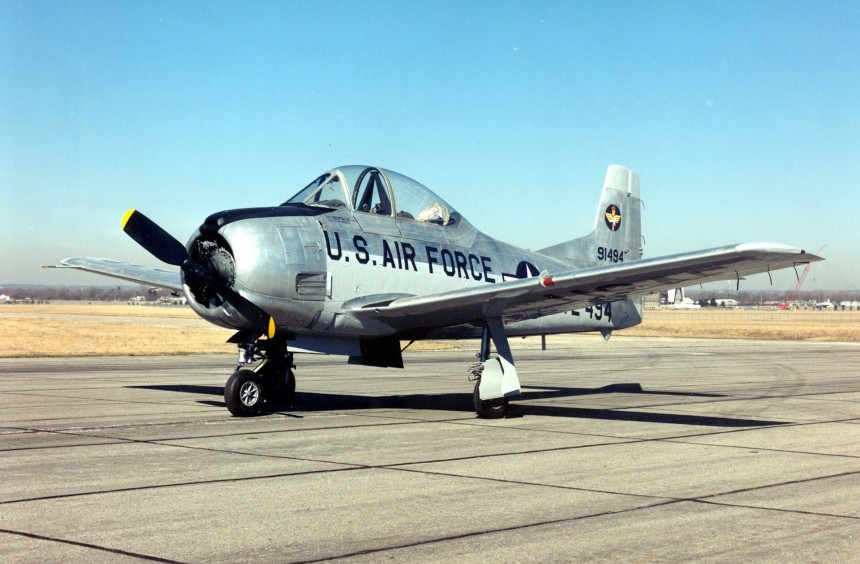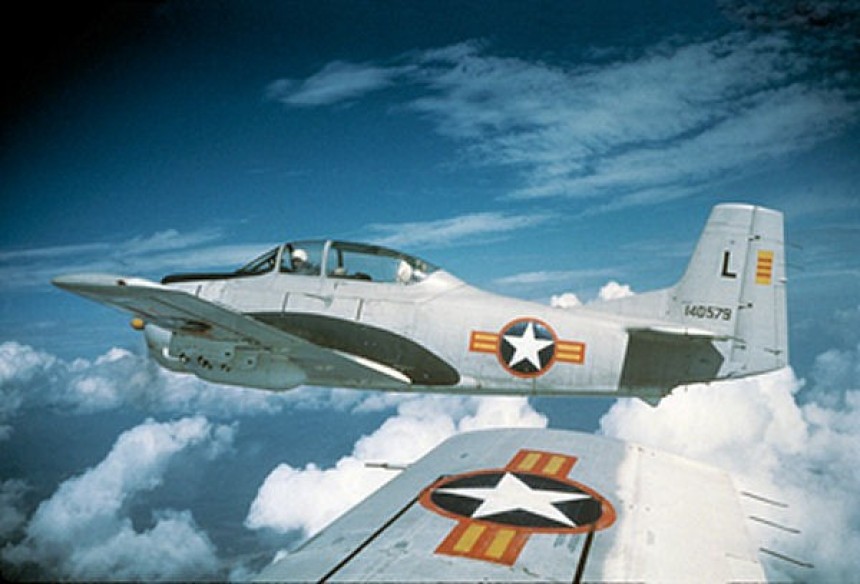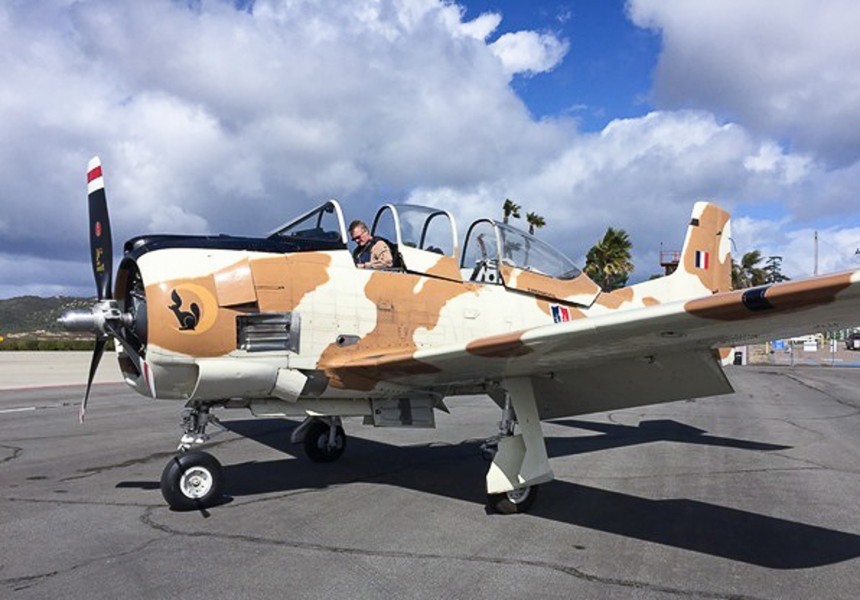A military trainer plane is the aeronautical equivalent of level one. A slow, stable platform where novice pilots work up their skills until, hopefully, they wind up in something far cooler and faster. When military aviation museums are full of Mustangs, Thunderbolts, and Spitfires, why give credence to anything else? The North American T-28 Trojan bucks this trend. Why? Because in the right configuration under the right conditions, it can outclimb a freakin P-51. No seriously, we're not pulling your leg.
The T-28's story is one rooted in traditional piston engine warbirds of World War II. But in the era of jet aircraft, just after the war, radial engines were about to prove they still had a place in military arsenals. During the Second World War, the U.S. Army Air Corps, Navy, and Marine Corps employed a number of different trainer aircraft. Perhaps none were more impactful or well remembered than the T-28's predecessor, the North American T-6 Texan.
Over 15,000 T-6s were built, mainly at North American Aviation's state-of-the-art production facility in Inglewood, California. With a small but furious Pratt & Whitney R-1340 Wasp radial engine and provisions to mount up to three 7.62 mm machine guns, the Texan wasn't just a phenomenal trainer plane but a decently effective combat aircraft when called upon. In the Arab-Israeli of just after World War II, a handful of T-6s under their export designation of Harvard even engaged in air-to-air combat, downing an Israeli Avia S-199 fighter during the conflict.
As far after World War II as Korea and Vietnam, T-6s were employed as Forward Air Control (FAC) aircraft, helping to guide dedicated close air support (CAS) aircraft to their targets while occasionally dropping their own ordnance if the opportunity arises. So to say, North American Aviation knew what it took to build a trainer plane that wasn't entirely useless outside of friendly air bases thousands of miles away from the fighting. This was the incredibly high standard that the T-6's successor aircraft would have to adhere to if it wanted a reputation even half as celebrated as it was itself.
With a significantly reduced workforce after the end of the Second World War, designing a new trainer was easier said than done. But even with staff cuts from over 90,000 employees down to just 5,000 after the war, North American Aviation still managed to get its new trainer, internal codename NA-159, into the air before the end of the 1940s, on September 24th, 1949. By 1950, the newly-christened XT-28 Trojan was delivered to the US Air Force's Air Proving Ground Command at Eglin Air Force Base in Flordia test trials. Safe to say, new recruits for the Navy and Air Force enjoyed North American's work.
With dimensions of 33 feet (10 m) long, a 40-foot, one-inch (12.22 m) wingspan, and a maximum takeoff weight of 8,500 lb (3,856 kg), the T-29 Texan was a short, dense machine with much of its curb weight coming from its single Wright R-1820 Cyclone nine-cylinder, air-cooled radial engine. Though the Trojan's engine traced its lineage back to the 1930s and World War II greats like the C-47 Skytrain and B-17 Flying Fortress, refinements to the design since then allowed it to crank between out 1,425 horsepower by the time the Navy-optimized T-28B variant made its first flight.
Meanwhile, the Air Force's bespoke variant, the T-28A, only made 800 horsepower. But even so, American pilots found the flight characteristics of both aircraft to be well above average. With a spacious, roomy cockpit that didn't squeeze new recruits into a proverbial tin can, new trainees could come to grips with the finer points of human-crewed, fixed-wing flight without claustrophobia hampering the experience. Its cable-driven non-hydraulically boosted controls also allowed pilots to learn the ropes without relying on new-fangled, overly-boosted control surfaces.
But in a way that few trainers before or since were, the Navy's T-28B and carrier-optimized T-28C distinguished themselves by being overpowered for their role. With a power-to-weight ratio that made World War II fighter pilots jealous, T-28Bs were famously faster to climb from takeoff to five thousand feet (1,524 m) than a Merlin V12-equipped P-51 Mustang. That's right, folks, the most famous and capable warbird of World War II couldn't climb as quickly as a lowly trainer plane made by the same company only half a decade after the war.
By the time North American Aviation ceased production in 1957, 1,948 T-28s had been manufactured between its A, B, and C variants in service with the US Air Force and Navy, but also countless other nations like France, Mexico, Brazil, Thailand, Taiwan, Japan, Saudi Arabia, and perhaps most famously, South Vietnam. Indeed, it was during the American intervention in Vietnam that the T-28 saw its most famous front-line service. As far back as 1963, a US-backed T-28 pilot from neighboring Laos defected over South Vietnamese lines to the North, where his plane was confiscated by the North Vietnamese Air Force and put into service as its first combat aircraft.
By the time of an escalated American presence in Indochina in the late 60s, a little-known and even less remembered aerospace firm named Pacific Airmotive was contracted to modify 321 T-28B and C airframes to accommodate a role as a ground attack-optimized, counter-insurgency plane. With six underwing hardpoints that carried a total of up to 1,200 lb (540 kg) of bombs, rockets, and machine gun pods, these updated T-28D Nomads were incredibly potent attack aircraft. Even outside of Vietnam, the concurrent Cambodian Civil War saw T-28D Nomads used as the Khmer Air Force's primary ground attack airplane.
A total of three generations of T-28D Nomads were manufactured in the 1960s. The final Mk.III variant's Wright Cyclone engine jetted a scarcely-believable 1,535 horsepower. Fun fact, that's 56 horsepower more than a non-Super Sport Bugatti Chiron. The more you know, right? But this was just one of several unique and quirky modifications done to stock T-28 airframes over the years. By the late 1950s, the French Air Force was modifying surplus USAF T-28As with supercharged Wright Cyclone engines similar to the ones used on the Boeing B-17 Flying Fortress WWII quad-engine bomber and dubbed the T-28S Fennec.
With provisions to carry all the same ordnance as the American T-28D plus a host of native French Matra rockets, French Military engagements in North Africa, particularly in the former colony of Algeria, were marked by modified T-28S Fennec's engaging in counter-insurgency activities in some of the most intense combat the type has ever seen. Back in the States, North Americans themselves had modified three T-28As to accommodate a 2,445 hp (1,823 kW) Lycoming YT-55L-9 turboprop engine and one M2 Browning .50 caliber machine gun in each wing root.
First flown in 1963, these modified airframes, dubbed the YAT-28E, were briefly considered for deployment to Indochina before the program was canceled in 1965. Whether bone stock or modified to the gills, T-28 airframes continued to prove useful to global air forces well into the late 20th century. The type was officially retired when its final remaining operator, the Philippine Air Force, struck their 12 T-28As from service in 1994, ending over four decades of continuous service.
Today, T-28s, in all their forms, have taken on a second life as museum pieces and air-worthy warbirds in the private sector. Thanks to its antiquated and relatively easy-to-maintain engine, operating costs for a T-28 are far lower than newer turboprop military trainers in the surplus market. It's to the point where even very small air museums like the Air Heritage Aviation Museum in Beaver Falls, Pennsylvania, can even fly their T-28 at air shows across the Northeastern United States, as countless other examples have also done across North America. For a lowly trainer, the Trojan is remarkably more special than most others.
Over 15,000 T-6s were built, mainly at North American Aviation's state-of-the-art production facility in Inglewood, California. With a small but furious Pratt & Whitney R-1340 Wasp radial engine and provisions to mount up to three 7.62 mm machine guns, the Texan wasn't just a phenomenal trainer plane but a decently effective combat aircraft when called upon. In the Arab-Israeli of just after World War II, a handful of T-6s under their export designation of Harvard even engaged in air-to-air combat, downing an Israeli Avia S-199 fighter during the conflict.
As far after World War II as Korea and Vietnam, T-6s were employed as Forward Air Control (FAC) aircraft, helping to guide dedicated close air support (CAS) aircraft to their targets while occasionally dropping their own ordnance if the opportunity arises. So to say, North American Aviation knew what it took to build a trainer plane that wasn't entirely useless outside of friendly air bases thousands of miles away from the fighting. This was the incredibly high standard that the T-6's successor aircraft would have to adhere to if it wanted a reputation even half as celebrated as it was itself.
With a significantly reduced workforce after the end of the Second World War, designing a new trainer was easier said than done. But even with staff cuts from over 90,000 employees down to just 5,000 after the war, North American Aviation still managed to get its new trainer, internal codename NA-159, into the air before the end of the 1940s, on September 24th, 1949. By 1950, the newly-christened XT-28 Trojan was delivered to the US Air Force's Air Proving Ground Command at Eglin Air Force Base in Flordia test trials. Safe to say, new recruits for the Navy and Air Force enjoyed North American's work.
Meanwhile, the Air Force's bespoke variant, the T-28A, only made 800 horsepower. But even so, American pilots found the flight characteristics of both aircraft to be well above average. With a spacious, roomy cockpit that didn't squeeze new recruits into a proverbial tin can, new trainees could come to grips with the finer points of human-crewed, fixed-wing flight without claustrophobia hampering the experience. Its cable-driven non-hydraulically boosted controls also allowed pilots to learn the ropes without relying on new-fangled, overly-boosted control surfaces.
But in a way that few trainers before or since were, the Navy's T-28B and carrier-optimized T-28C distinguished themselves by being overpowered for their role. With a power-to-weight ratio that made World War II fighter pilots jealous, T-28Bs were famously faster to climb from takeoff to five thousand feet (1,524 m) than a Merlin V12-equipped P-51 Mustang. That's right, folks, the most famous and capable warbird of World War II couldn't climb as quickly as a lowly trainer plane made by the same company only half a decade after the war.
By the time North American Aviation ceased production in 1957, 1,948 T-28s had been manufactured between its A, B, and C variants in service with the US Air Force and Navy, but also countless other nations like France, Mexico, Brazil, Thailand, Taiwan, Japan, Saudi Arabia, and perhaps most famously, South Vietnam. Indeed, it was during the American intervention in Vietnam that the T-28 saw its most famous front-line service. As far back as 1963, a US-backed T-28 pilot from neighboring Laos defected over South Vietnamese lines to the North, where his plane was confiscated by the North Vietnamese Air Force and put into service as its first combat aircraft.
A total of three generations of T-28D Nomads were manufactured in the 1960s. The final Mk.III variant's Wright Cyclone engine jetted a scarcely-believable 1,535 horsepower. Fun fact, that's 56 horsepower more than a non-Super Sport Bugatti Chiron. The more you know, right? But this was just one of several unique and quirky modifications done to stock T-28 airframes over the years. By the late 1950s, the French Air Force was modifying surplus USAF T-28As with supercharged Wright Cyclone engines similar to the ones used on the Boeing B-17 Flying Fortress WWII quad-engine bomber and dubbed the T-28S Fennec.
With provisions to carry all the same ordnance as the American T-28D plus a host of native French Matra rockets, French Military engagements in North Africa, particularly in the former colony of Algeria, were marked by modified T-28S Fennec's engaging in counter-insurgency activities in some of the most intense combat the type has ever seen. Back in the States, North Americans themselves had modified three T-28As to accommodate a 2,445 hp (1,823 kW) Lycoming YT-55L-9 turboprop engine and one M2 Browning .50 caliber machine gun in each wing root.
First flown in 1963, these modified airframes, dubbed the YAT-28E, were briefly considered for deployment to Indochina before the program was canceled in 1965. Whether bone stock or modified to the gills, T-28 airframes continued to prove useful to global air forces well into the late 20th century. The type was officially retired when its final remaining operator, the Philippine Air Force, struck their 12 T-28As from service in 1994, ending over four decades of continuous service.
